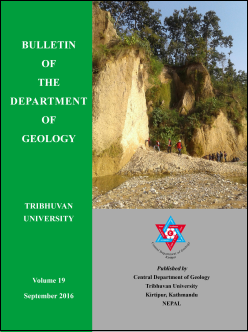Fluvial morphology and dynamics of the Godavari Khola, southeast Kathmandu, Central Nepal
DOI:
https://doi.org/10.3126/bdg.v19i0.19990Keywords:
Fluvial morphology, stream classification, aggrading stream, degrading stream, Bagmati RiverAbstract
The Godavari Khola flowing from the south to the north contributes the Hanumante Khola, which is one of important tributaries of the Bagmati River, flowing from the eastern part of the Kathmandu Basin. Recently, the Godavari Khola has been suffering from human encroachments due to rapid urbanization. Studying nature and dynamics of the stream are important works if the stream has to be made less affected and well managed. The present study aims to establish fluvial morphology and stability status of the Godavari Khola. For these purposes, the watershed was analysed for morphometric parameters and planform fluvial morphology, and thirteen representative segments were surveyed from upstream to downstream of the Godavari Khola for recording and analysing sediment properties, stream cross-sections and profiles, and hydraulic parameters, river dynamics and stability.
The Godavari River is a fifth order stream, the two upstream segments of which are bedrock channels, and the rest of the segments are alluvial channels. The segments are classified into six kinds such as C4-, C5-, B3-, B4-, E4- and F4-type streams. The upstream segments are of B4-, B3- and ‘F4’-types which show entrenched, steep, gravel to cobble grade streams. The downstream segments are of C4-, C5-, E4- and F4-types showing non-entrenched to low entrenched streams with gentle slopes, high sinuosity and gravel to sand grade bed materials. The stability status of the Godavari Khola shows that the stream segments 1, 2, 11 and 13 lie in the degrading condition whereas the remaining nine segments lie in the aggrading condition. Because of the huge width/depth ratio in majority of the downstream channels, bank erosion is relatively prone in the downstream segments of the Godavari Khola, whereas bed incision is prone in segments 11 and 13.
Bulletin of the Department of Geology, Vol. 19, 2016, pp. 15–28
Downloads
Downloads
Published
How to Cite
Issue
Section
License
© Central Department of Geology, Tribhuvan University, Nepal

